
I was invited to join the “Rocksolid Challengers” team through a running friend of mine, Colin, but I didn’t meet two of the other team members, Rocks (who was sponsoring the team) and Burge, until the morning of the race. I was a little apprehensive about this as spending 15-16 hours with someone the first time you meet them, knowing I was going to have all my normal social filters stripped away through the ardours of running an ultra. I needn’t have worries as the guys were great fun and very welcoming. They seem to think that I’d breeze around, and that I was going to be the one to pull them round in under 15 hours (the team target given last year’s 15:23 time).
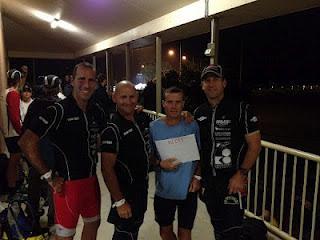
The Challengers fresh and enthusiastic before the start
The planning was meticulous from the team with a breakdown of our split times calculated using a complex algorithm based upon the encroachment of tiredness, hills, last year’s times and how long we stopped at Burge’s Dad’s house for soup and a sit down (as it was conveniently on the course)!
What we didn’t know at the start that the course had been significantly altered from previous years with an addition 500m climb thrown in, to increase the “fun” level!
At the start line by chance we were standing next to a group of runners who I had bumped into in Ikea about a year ago, who had sparked up conversation because of the t-shirt I was wearing for my 33 Marathons run. I’d kept in touch with Marlene and Glen, and since I’d last met them, they had run MDS and Comrades. It’s a great feature of running in ultras that you do meet up with friendly people, each time with new inspiring stories to tell.
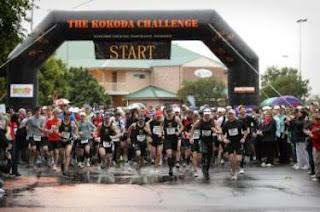
The early part of the race is fairly gentle with a few road stretches, and this was a good thing to spread the field before we hit the single tracks. It was also good for me to get to know the guys in the team, and get a feel for the right pace to run at. It was a concern before the race to be sure to run at a pace that works well for the entire team. What I found was that we were all fairly similar on the easy tracks and then we’d all adjust on the more technical or steep sections, where we’d spread out a little, and then merge back together as the trails levelled off.
I always find it interesting in those early stages where you’re running close quarters with lots of runners. There are as many different gaits as there are people. There seemed to be two main categories of style displayed on the steep hills, especially when it’s very muddy, which I put down to those who had come from a road running background and those who trained more on the trails (this may be a big over assumption, but it seemed right to me at the time).
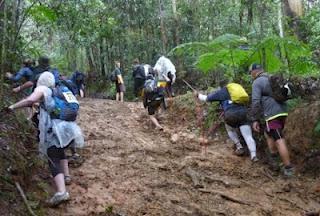
Yet another muddy track to deal with
What I noticed is that the “road runners” tend to push as they toe-off (as you would on the roads) and their foot then slips back in the mud. This is wasting a lot of energy for no forward gain. The trail runners tend to lift their foot off the ground, without sliding, and hence run more efficiently (also they seem to have a short stride).The Kokoda Challenge has plenty of checkpoints, typically about every 10kms, but most are just to check in and only have water and a few lollies available. This helps break the race down into mentally more manageable sections. As ever the volunteers at these checkpoints were great with words of encouragement, and updates as to where you were in the field. I was surprised to hear that we were in the top ten and we seemed to be traveling well.
The hills were severe and relentless, and they really test the team as a whole. I’ve always been pretty comfortable with hills, especially when they’re so steep that running is impossible. I put my head down, disengage my brain and power walk with brisk short strides until it flattens out. It wasn’t discussed, but I had it in my head that from a team perspective we’d run together where we could and on the more challenging sections we’d run or walk at our own pace and then regroup. This seemed to be the way it was going with most groups, at least early on before the tiredness kicked in and reserves got low.
The challenge with having a variety of paces in a group comes at the regrouping stage. When the slower members of a group catch up it’s all too easy to start running again not giving them the chance to rest. The problem is made worse because the faster runners who got to the top sooner are refreshed and feel able to run on faster. We were very conscious of this, and would always allow the slowest paced runner to dictate when a rest should be taken. The danger is that the slower team members getting pulled along quicker than they are comfortable, even though they think they are Ok. It’s a long day at the office in any Ultra and although you may be thinking checkpoint to checkpoint, you need to be cognizant of the bigger picture.
The downhills were a lot of fun and in my case a lot of fun for those around me. The track was so thick with mud that it was difficult to remain upright, something that I failed at twice within the course of a few hundred metres. The second spill, right onto my backside in thick mud was right in front of a handful of spectators who had clearly identified this section as one where they would be entertained. I’m sure there will be some video on YouTube to document this as they all had cameras in hand.
The team were quick to point out that it looked like I had had an unfortunate incident caused by a dodgy curry the night before. Luck was on my side though as at the bottom of the hill there was a ford, which I chose to sit in and wash my backside! I was very grateful for this as the prospect of running for a few more hours with grit and sand in my shorts was not appealing.
Early creek crossings were taken with great care trying to keep feet dry. This was effective for the first 6 but then there was no other option than to wade in as the normal stepping stones were well underwater. I didn’t count, but there must have been at least another 10 crossings after that. All of our feet were pretty well pickled but I managed mine by putting on fresh socks every 20-25kms. This was a great tactic as it felt as though I had new dry shoes on, and the Drymax socks actually help dry your feet out. At the end of the day I had no blisters which I put down to my Hokas and my Drymax socks, under what must have been the toughest of conditions.
Another benefit of the Hokas was that the lovely big sole helped keep my feet dry and above the water on occasion when those around were getting wet feet! My kit for the day performed incredibly well. The Linebreak compression shorts and calf guards kept me running and cool, and the Ay-Up head torch turned night into day and allowed me to run with confidence on technical trails.
At the 35km checkpoint Rocks, our team captain, was really suffering and told us he was withdrawing. We as a group and independently tried to talk him round with different motivations, but he had made his mind up and didn’t want to hold the rest of us back. It’s a tough decision to make, and when you’re depleted it’s difficult to rationalise when your brain is telling you to stop. It was disappointing to lose a team member, mostly because we felt sure he would come back and feel Ok and then regret the decision. So we then had to use this as our motivation to do him proud. He stayed with the support crew and was a tremendous help for the rest of the day, never did he indulge in self pity, he just focused on all of us reaching that 15 hour goal.
We had two teams running, and while we were a group of non elite class athletes, the other team, "Rocksolid Raiders" were made up of world class Triathletes and Ironmen. I don’t know if it was a tactic of the support crew but with each checkpoint they were giving us updates on how far apart we were. Every time we were told we were gaining on them, and that they were tiring! This gave us something to think and fantasise about, and being a competitive lot it helped push us on into the night. It’s amazing what reserves you can find when the motivation is there.
Another interesting benefit of team running was around nutrition. Personally I rely on remembering when to eat and drink, which on occasion has let me down. With the team we were all reminding each other all the time, sharing foods, salt tabs, fluids, whatever anyone needed, and throughout the day I only felt a little nauseous once (which I quickly rectified). This doesn’t just work within the team, but between teams too.
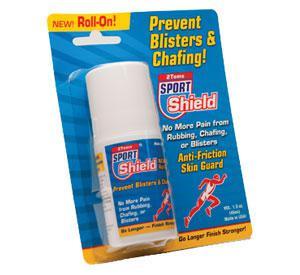
Does exactly what it says on the packet!
At the halfway point we met with the leading team at a checkpoint (we weren’t up with them, it was an out and back section and they were 13kms ahead!). Andy Lee, a former TNF 100 winner was suffering with some chaffing, not something you want with 40kms to go. As a team we had been provided with the 2Toms Sports Shield (which I’ve recently reviewed) and we gave Andy some which must have worked well for him as they went on to win by a big margin. Our team used it, and there were no reports of any hot spots or chaffing even under the wet conditions we faced on the day.Later in the race we were running with another mixed group, and the lady on the team was suffering with a knee injury. Burge came to the rescue with some pain killers, which was more help than the rest of her team offered! It’s this sort of spirit that you see at every ultra race, and one of the reasons why I love the sport so much.
The team planning was derailed by the course changes this year, as we were about 25 minutes ahead of schedule for our sub 15 hour goal when we started on the extra hill climb, and then about 15mins behind by the next checkpoint. It was quite comical listening to the others saying “I don’t remember this” and “this is the last hill”, but no matter what was said the hill was still there and still had to be climbed. You can moan and complain, but that will only make the task harder. By choosing to stay in the moment, and focus on the job in hand it passes more quickly and with much less discomfort.
Although the slick trails were challenging to run on, especially on the steep and dark sections, I found it actually helped take my mind off the “hill” and made me concentrate on where I was going to put my foot to get the most traction, the bail out route if I did slip, and what I could grab hold of to help me along. Looking back on the race the hills didn’t seem that bad which I put down to my mind being absorbed in the task.
Leaving the final checkpoint we were told that our other team were only a few minutes ahead, so we pushed as hard as we could as a team, being careful not to go too hard. This motivation was again a great distraction from the physical stress of the event, and in the first 20 minutes of this section we passed the two other teams that we had been leap frogging all day. Every time we caught up with anyone we were asking if they had seen a team of super fit looking guys in black, and they were not too far ahead.
The final few kms were downhill, and pretty steep. Very nice if you’re out for a short jog, but after 15 hours of trashing you quads on the trails, it was a far tougher proposition. The conversation got lighter as we saw signs of civilization and we knew we were getting close to home. We enjoyed some spectacular views across to the Gold Coast, and thought what an alien world the bright lights of Surfer’s Paradise were to where we had been all day.
The finish line beckoned with the sound of the announcer. We crossed the line together, and enjoyed our rockstar moment of camera flashes and the presentation of our certificates and military style dog tags on the stage. Not knowing what to expect from the day, I did thoroughly enjoy it. The good times far outweigh the bad, and the company was first class.
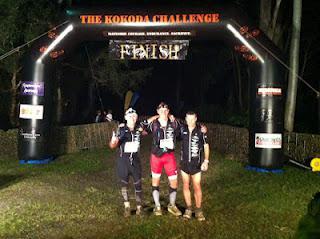
So all in all a great day, which truly lived up to the ideals on which is was based.
Run Happy!
Andy
"It never get's easier, you just get better"www.ultramarathonrunning.com.au

